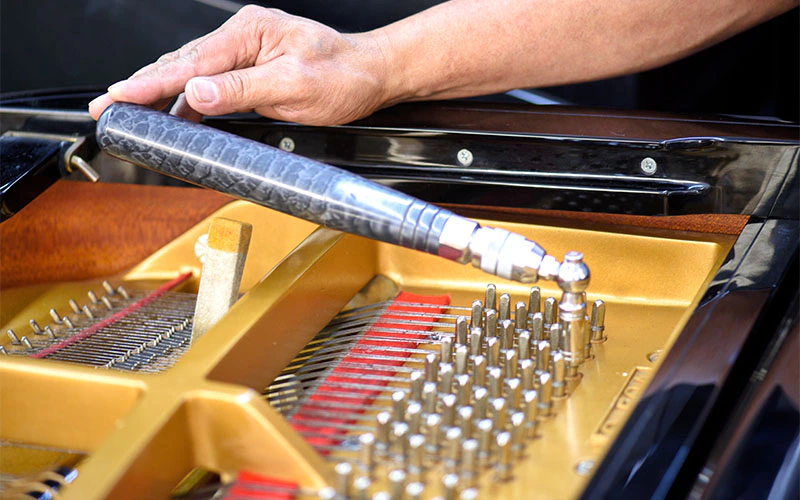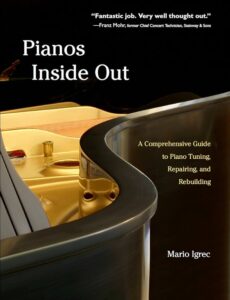How to tune pianos, start by checking all the keys’ pitches, then adjusting the strings accordingly. Regularly maintaining piano tuning ensures a consistent, pleasant sound for playing and listening.
Tuning a piano is essential for maintaining the instrument’s integrity and producing the correct notes. It entails altering the string tension to coincide with the typical pitch frequencies. Proper tuning not only improves the sound quality but also increases the longevity of the piano.
Understanding the subtleties of piano tuning necessitates ability and precision, making professional tuners indispensable. To keep the piano in good playing condition, it should be tuned at least twice a year. To acquire the greatest results, familiarize yourself with the tuning procedure and consider hiring an expert.

How to Tune Pianos in the Basics Level
Tuning a piano is an important part of piano maintenance because it ensures that the instrument generates the correct pitch for each key. Tuning a piano correctly involves precision and knowledge, therefore it is critical to learn the foundations before tackling the operation. This guide will go over the importance of regular piano tuning as well as the tools needed for the job.
The Value of Regular Piano Tuning
Regular piano tuning is essential for preserving the instrument’s integrity and achieving the best possible sound quality. Environmental factors such as temperature and humidity fluctuations affect pianos over time, causing subtle changes in string tension. Without regular tuning, the pitch of the piano may shift, producing a dissonant sound. Furthermore, ignoring tuning can lead to more serious problems, harming the piano’s longevity and performance.
Instruments Required for Piano Tuning
Having the correct equipment for tuning a piano is critical for attaining accurate results. The basic tools necessary for piano tuning are as follows:
- Tuning lever or wrench
- Piano tuning hammer
- Felt temperament strip
- Mutes
- Pitch raise lever
- Electronic chromatic tuner
Each of these tools is essential in the tuning process, allowing the technician to precisely alter the tension of the piano strings.
Identifying When Tuning Is Needed
Regular tuning is essential for preserving a piano’s best sound quality and pitch. A shift in tone or pitch is an indication that a piano needs to be tuned. To ensure peak performance, have a professional tuner check the piano’s condition and make any required modifications.
Recognizing changes in sound quality
The sound quality of a piano can alter over time due to a variety of factors such as temperature fluctuations, humidity levels, and continuous usage. Recognizing these shifts is critical. Examine the keyboard for any discordant or muffled notes, off-pitch sounds, or inconsistent tones. These variations are clear signals that the piano needs to be tuned.
Symptoms of Piano Detuning
There are various detuning signals that can assist owners recognize when their piano needs to be tuned. String tension loss, shaky tuning pins, and obvious pitch disparities are all indications of a detuned piano. Furthermore, when a piano is out of tune, the keys can feel different to the touch and provide variable sound quality. To detect these indicators early, it is critical to routinely monitor, listen to, and test the piano.
Tuning preparations
It is critical to prepare the instrument before tuning a piano. Begin by cleaning up the surrounding space and ensuring adequate illumination for the task. It’s also critical to have all of the appropriate tools and equipment on hand to speed up the tuning process.
Creating a Work Environment
It is critical to set up a good work environment before commencing the piano tuning process. This entails selecting a well-lit, roomy location with few distractions. It’s also a good idea to use a soft cloth or mat to protect the piano’s surface from scratches or damage. Ensure that the temperature and humidity levels in the room are within the prescribed ranges to avoid variations that could interfere with the tuning process.
Carefully handling the piano
Once the work environment is in place, it is critical to handle the piano with extreme caution. Before tuning, assess the piano for any existing damage or loose components that may require care. It is also critical to raise and transport the piano with care, ensuring that it is supported evenly and securely to avoid any harm to its delicate internal parts.
How To Tune Pianos Step By Step
Tuning a piano may be a time-consuming task that demands patience, attention to detail, and an ear for pitch. A methodical technique is required to ensure that each note creates the desired sound. The following is a step-by-step tutorial on tuning pianos, including the important aspects of stabilizing tuning pins and changing string tension for proper pitch.
Stabilizing The Tuning Pins
The first step in piano tuning is to secure the tuning pins. This procedure entails making certain that the pins are securely fastened in place to prevent them from slipping during tuning. Follow these steps to stabilize the tuning pins:
- Check for any loose tuning pins that may cause instability in pitch.
- Tighten any loose tuning pins using a tuning hammer to firmly secure them in place.
- Verify the stability of the pins by gently tapping on them to ensure they do not move or produce a buzzing sound.
String Tension Adjustment for Proper Pitch
After securing the tuning pins, the string tension must be adjusted to achieve the correct pitch for each note. This can be accomplished by taking the following steps:
- Identify the current pitch of the string by using a tuning fork or a digital tuner as a reference.
- Turn the tuning pins using a tuning lever to adjust the tension of the strings until the desired pitch is achieved.
- Continuously check the pitch accuracy of each note by comparing it to a reference pitch and making necessary adjustments.

Techniques and Strategies for Tuning
Tuning a piano necessitates dexterity and skill. Several tuning procedures and strategies must be used to attain perfect harmony and balance on the instrument. A piano tuner must have a thorough understanding of these fundamental ideas, which range from comprehending the differences between equal temperament and just intonation to mastering octave and unison tuning.
Equal Temperament Versus Just Intonation
Equal temperament is a tuning system in which the octave is divided into 12 equal pieces, allowing all keys to share the same intervals. This method assures that each key is equally in tune, making it appropriate for contemporary Western music. Just intonation, on the other hand, is based on pure mathematical ratios of the harmonic series, resulting in a more natural and harmonious sound. While certain classical and non-Western music prefer just intonation, equal temperament remains the usual tuning method for most pianos due to its adaptability.
Octave and Unison Tuning Suggestions
It is critical to ensure that the upper and lower notes sound harmonious and in perfect sync when tuning the octaves. A tuning lever can be used to make micro-adjustments to the strings, ensuring that both ends of the octave output the same frequency.
Begin by finding the most strained or dissonant notes for unison tuning. Using a tuning lever, carefully adjust the tension of the strings to eliminate any beats or dissonance, resulting in a seamless and uniform tone across all the strings in unison.
Managing Common Tuning Challenges
Tuning pianos demands precision and expertise, yet even the most competent piano tuners can run across typical problems. Being able to efficiently manage these problems ensures that the piano stays in tune for extended periods of time, producing ideal performance. Let’s look at some of the most prevalent tuning issues and how to solve them.
Advanced Piano Tuning Tactics
When the partials of a piano string are not exact integer multiples of the fundamental frequency, string inharmonicity arises. This might result in a lack of regularity in tuning and a less-than-desirable sound. To address this issue, use proper tuning techniques, such as fine-tuning the octaves and using aural tuning methods, to generate a more harmonic sound over the entire register. Additionally, using machines with inharmonicity correcting capabilities can help to address this issue more accurately.
Resolving Common Tuning Stability Issues
Frequent tuning stability concerns might arise as a result of temperature and humidity fluctuations, as well as the natural settling of new strings. Use high-quality strings that are less prone to stretching and slippage to maintain constant tuning stability. Regular maintenance is essential for addressing stability difficulties, so look for any faulty pins, loose wrestplanks, or worn-out action components that could interfere with tuning. Using a humidity control system in the piano’s environment can also assist in maintaining stable conditions for the strings, reducing the influence of temperature and humidity changes.
Tactics for Advanced Piano Tuning
Mastering advanced methods is vital for achieving professional and precise piano tuning. These advanced piano tuning procedures entail intricate fine-tuning processes as well as thorough management of environmental elements that might impact the pitch and overall sound quality of the instrument.
Methods for Fine-Tuning
Professional piano tuners must be able to master complex piano tuning procedures. These techniques necessitate fine modifications to the instrument’s strings and components in order to create perfect sound balance and harmony. Some sophisticated techniques are as follows:
- Pitch raise and lowering: Fine-tuning the pitch of each string to achieve precision and uniformity across the entire piano.
- Inharmonicity adjustments: Addressing the natural inharmonicity of piano strings to ensure the ideal harmonic intervals and resonance.
- Unison tuning: Carefully adjusting the multiple strings of a single note to resonate in perfect harmony.
- Regulation techniques: Fine-tuning the piano’s action and key response for optimal touch and responsiveness.
Managing Environmental Factors
Humidity, temperature variations, and acoustic circumstances can all have a substantial impact on a piano’s tuning stability. Managing these parameters is critical for preserving the instrument’s tuning integrity. The following are advanced strategies for dealing with certain environmental factors:
- Humidity control: Implementing humidity control systems to minimize the impact of moisture on the piano’s soundboard and strings.
- Temperature regulation: Maintaining a consistent temperature in the piano’s environment to prevent fluctuations that can affect the tension of the strings.
- Acoustic adjustments: Optimizing the piano’s positioning and room acoustics to enhance the instrument’s resonance and overall sound quality.
Ensuring Tuning Precision
Precision is essential when it comes to piano tuning. To achieve perfect pitch and tone across the entire keyboard, rigorous attention to detail and a complete understanding of the instrument’s mechanics are required. Whether you’re a professional piano technician or a hobbyist trying to keep your own instrument in good working order, precision tuning is critical for best performance and durability.
Pitch accuracy testing
The first step toward achieving precision in piano tuning is to verify pitch correctness. Assess the pitch of each note on the keyboard using a high-quality electronic tuner or tuning app. Take note of any substantial discrepancies and identify areas that need to be adjusted. To effectively measure the pitch of an instrument, you must have a sharp ear and a good comprehension of musical intervals.
Strategies for Long-Term Tuning Maintenance
Implementing effective maintenance procedures is essential for ensuring long-term precision in piano tuning. This involves frequent structural integrity inspections, keeping the piano in a stable environment to reduce humidity and temperature variations, and scheduling routine tuning sessions with a trained technician. Furthermore, the usage of humidity control devices, as well as adequate cleaning and care, can contribute to long-term tuning precision.
Increasing your understanding of piano tuning
The art of piano tuning necessitates a consistent effort to broaden knowledge and enhance skills. Continuous learning is essential for mastering the art, whether you are a beginner looking to dig further into the realm of piano tuning or an experienced technician looking to stay informed with the latest techniques and tools. This section will look at useful resources for continuing education, certification, and professional growth in the subject of piano tuning.
Continuous learning resources
Using a range of resources to improve your piano tuning expertise can be really beneficial. Here are some excellent ways to broaden your knowledge:
- Obtaining certification from recognized organizations, showcasing your proficiency and credibility
- Participating in specialized training programs and workshops to refine your skills
- Networking with industry leaders and experts to gain valuable insights and mentorship

Credit: www.amazon.com
Frequently Asked Questions About Piano Tuning
Can You Tune Your Own Piano?
It is not advisable to tune a piano on your own. It necessitates talent and knowledge. For the greatest results, get a professional tuner.
How Do You Perfectly Tune a Piano?
Hire a professional tuner with experience and a solid reputation to precisely tune a piano. They will adjust the tension of each string using specialist tools to ensure proper pitch and a harmonious tone. Regular tuning is required to keep the piano in good condition.
How Much Does It Cost To Tune My Piano?
Piano tuning normally costs between $100 and $200. The final cost might be influenced by factors such as the condition of the piano and the technician’s expertise. For an exact quote, it is best to contact a professional tuner. Tunings should be performed every 6-12 months.
What Are the Signs That Your Piano Is Out of Tune?
When the notes on a piano sound odd or lack harmony, you know it’s out of tune.
Conclusion
To achieve the highest sound quality, piano tuning takes experience and precision. You can keep your piano performing at its best by following the procedures described in this tutorial. Regular maintenance and professional tuning are required to keep your instrument in good working order.
Keep your piano in tune so you can enjoy lovely songs for many years.
To check our more blogs Click Here


